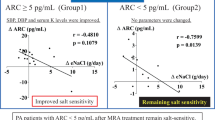Abstract
Two double-blind, placebo-controlled, balanced cross-over studies were carried out successively in 8 male normotensive volunteers to investigate the acute and chronic effects of two doses of a novel non-steroidal anti-inflammatory drug flosulide (5 mg b.d. and 25 mg b.d.), on the renin-angiotensin-aldosterone system, linking this to changes in the urinary excretion of prostaglandins. Plasma renin and aldosterone were determined on Days 2 and 9, with the subject supine, after 1 h of rest in the sitting position following 1 h of walking, and 3 h after oral intake of 40 mg furosemide, also in the sitting position. Twenty-four hour urine samples were collected on Days 1 and 8 for the measurement of the electrolytes, aldosterone pH1 and the urinary prostaglandins PGE2, PGF2α, 6-keto-PGF1α and TxB2.
Results: After the first day of treatment with 25 mg b.d. flosulide, the increase in body weight was close to significance (0.86 vs -0.08 kg with placebo). A dose-and time-dependent decrease in both active and inactive plasma renin were observed, whereas the fall in plasma and urinary aldosterone was statistically significant only after the higher dose of flosulide. These changes in the renin-angiotensin-aldosterone system were observed in the absence of oedema.
Two out of eight volunteers experienced a strong and immediate reduction in the excretion of prostaglandins but overall the two doses tested did not produce a statistically significant inhibition in renal prostaglandins, especially following repeated dosing. The inhibitory effect of flosulide on renal prostaglandin synthesis was found to be less pronounced after repeated treatment, as documented on Day 9 by the lower inhibition of 6-keto-PGF1α and TxB2.
Conclusion: These two studies in normal volunteers, in spite of some methodological limitations, were helpful in order to select doses of flosulide which should be effective and safe in patients during Phase II trials, by examining the inhibitory effect of the drug on renin synthesis and renal prostaglandin synthesis.
Similar content being viewed by others
References
Ménard J, Guyene TT, Corvol P, Pau B, Simon D, Roncucci R (1985) Direct immunometric assay of active renin in human plasma. J. Hypertension 3:275–278
Sealey JB, Atlas SA, Laragh JH, Oza NB, Ryan JW (1979) Activation of a pro-renin-like substance in human plasma by trypsin and urinary kallikreins. Hypertens. 1:179–189
Hornych A, Forette F, Bariety J, Drief C, Aumont J, Paris M (1991) The influence of age on renal prostaglandin synthesis. Prostaglandins leukot essent Fatty Acids 1:191–195
Dray F, Charbonnel B, Maclouf J (1975) Radioimmunoassay of prostaglandins F, E1 and E2 in human plasma. J Clin Invest 5:311–318
Hornych A, Kief C, Bariety J (1982) Radioimmunoassay measurements of thromboxane B2 in human plasma and urine. Prostagland leukot Med 8:467–480
Gary NE, Dodelson R, Elsinger RP (1980) Indomethacin-associated acute renal failure. Am J Med 69:135–136
Donker A, Arisz L, Breutjens J (1976) Effect of indomethacin on kidney function and plasma renin activity in man. Nephron 16:288–296
Motwani JG, Struthers AD (1994) Interactive effects of indomethacin, angiotensin II and frusemide on renal haemodynamics and natriuresis in man. Br J Clin Pharmacol 37:355–361
Final report Study A 102, Part I. Gastroscopic evaluation of gastrointestinal tolerability after subchronic treatment with CGP 28 238, indomethacin and placebo in healthy volunteers. Human Pharmacology Institute Tübingen, Ciba-Geigy GmBH, August 1988
Final report Study A 102, Part II. Gastroscopic evaluation of gastrointestinal tolerability after subchronic treatment with CGP 28 238, indomethacin and placebo in healthy volunteers. Human Pharmacology Institute Tübingen, Ciba-Geigy GmBH, November 25, 1988
Patrono C, Publiese F, Ciabattoni G, Patrignani P, Maseri A, Cherchia S, Peskar BA, Cinotti GA, Simonetti BM, Pierruci A (1982) Evidence for direct stimulatory effect of prostacyclin on renin release in man. J Clin Invest 69:231–239
Frölich JC, Wilson TW, Sweetman BJ, Smigel M, Nies AS, Carr K, Watson JT, Quates JA (1975) Urinary prostaglandins. Identification and origin. J Clin Invest 55:763–770
Weber PC, Larsson C, Anggard E, Hamberg M, Corey EJ, Nicolaou KC, Samuelsson B (1976) Stimulation of renin release from rabbit renal cortex by arachidonic acid and prostaglandin endoperoxides. Circul Res 39:868–874
Fitzgerald GA, Hossmann V, Hummerich W, Konrads A (1980) The renin-kallikrein-prostaglandin system: Plasma-active and inactive renin and urinary kallikrein during prostacyclin infusion in man. Prostaglandins Med 5:445–456
Grantham JJ, Orloff J (1968) Effects of prostaglandin E1 on the permeability response of the isolated collecting tubule to vasopressin, adenosin 3′5′-monophosphate, and theophylline. J Clin Invest 47:1154–1161
Author information
Authors and Affiliations
Rights and permissions
About this article
Cite this article
Brunel, P., Turri, M., Hornych, A. et al. Renal and endocrine effects of flosulide, after single and repeated administration to healthy volunteers. Eur J Clin Pharmacol 49, 193–201 (1995). https://doi.org/10.1007/BF00192379
Received:
Accepted:
Issue Date:
DOI: https://doi.org/10.1007/BF00192379




